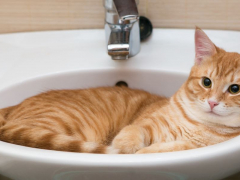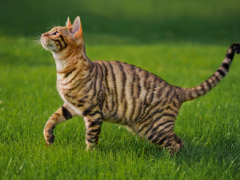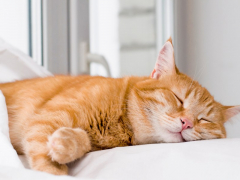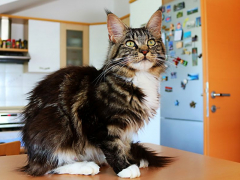
Kirsten McCarthy / Cats.com
If you’ve ever stumbled across hydrolyzed protein diets for pets and wondered what they are, you’re not alone! The modern huge range of cat foods on offer is excellent news for felines, but all the different types can be confusing for us owners. Hydrolyzed foods refer to special diets where the food protein molecules have been broken down by a process called hydrolysis and are aimed at cats with food allergies or intolerances.
Hydrolyzed Protein Cat Foods: What Are They?
Food contains nutrients, which are digested by the body to fuel our activities, growth and development. Proteins – complex molecules important in the growth and function of many parts of the body – are a key part of any balanced diet. As obligate carnivores, common protein sources in commercial cat diets are often animal or fish-based, such as chicken, beef or salmon.
Traditional cat foods keep these protein molecules intact, ready for them to be broken down by the cat’s digestive system. However, for some pets, these protein molecules can cause problems, such as an inflammatory or immune response in cats with food allergies or conditions such as inflammatory bowel disease (IBD).
In hydrolyzed protein pet foods, the large protein molecules are broken down (hydrolyzed) into very small particles. This disruption and alteration to the protein molecules are designed to stop the cat’s immune system from recognising – and therefore reacting to – them, providing a diet that nourishes rather than upsets.
What Are Hydrolyzed Diets Used For?

Protein sources in commercial cat foods often include meat and fish. Kirsten McCarthy / Cats.com
As a veterinarian, there are two main scenarios in which I would suggest a hydrolyzed protein diet: food allergies and chronic inflammatory gut conditions.
If I diagnose any gastrointestinal conditions in a cat, I always consider diet as a hugely important part of a holistic treatment plan. Recent studies show encouraging results as to the use of hydrolyzed diets in patients with IBD and food allergies.
Food Allergies
Cats with food allergies mount an immune response to certain nutrients in their diet – commonly a protein source. Hydrolyzed diets provide a food with the potential allergens (the protein molecules) altered sufficiently to prevent the immune system from reacting, therefore also preventing the resulting digestive upset.
Hydrolyzed diets are also suitable for cats with food sensitivities or intolerances – a reaction to certain foods that don’t involve the immune system but still cause problems with digestive health. These diets can meet cats’ specific needs for their diet, whilst reducing symptoms such as vomiting or diarrhea.
Chronic Digestive Conditions
Chronic health conditions leading to inflammation of the gut, such as IBD, are thought to be caused by an inappropriate immune response to certain foods. Hydrolyzed diets provide highly digestible nutrients, allowing cats with altered bowel function to digest and process the food better.
How Do I Know if My Cat Needs a Special Diet?
Food intolerances and other chronic gastrointestinal conditions often cause a similar set of symptoms:
Food allergies can also cause dermatological signs:
- Excessive scratching and itching, lead to overgrooming
- Alopecia (hair loss)
- Red, sore patches of skin
- Scabs or papules (raised red spots)
- Self-induced wounds
If you notice any changes to your cat’s skin, or to their eating, digestion, and toileting habits, it’s a good idea to book them in for a vet check.
Key Benefits and Problems With Hydrolyzed Diets
As well as avoiding certain adverse immune responses to common proteins, hydrolyzed protein cat foods have been carefully formulated to be suitable as a long-term diet for cats who need it.
As well as a highly digestible protein source designed to prevent adverse reactions, these diets should provide appropriate levels of omega-3 fatty acids, vitamins, minerals, essential amino acids, and antioxidants to support both immune function and digestive health, as well as healthy skin and coat health.
The main concerns with hydrolyzed diets have to do with taste and texture, as the hydrolysis process can alter palability. This appears to be improving as more research and development have been channeled into providing suitable options for cats who need these diets.
How Do I Switch My Cat to a Hydrolyzed Protein Cat Food?
A hydrolyzed protein cat food is only suitable for some cat’s specific needs, so the transition should be made under the direct care and supervision of a veterinarian. These diets usually require a prescription from your veterinarian. The vet will also be able to advise if any other cats in the household can be on the same diet, to prevent accidental ingestion of a non-hydrolyzed food.
If your vet has recommended a hydrolyzed food for your cat, you may need to try a few different types to find one that best suits your cat’s specific needs. Many of these diets come as both dry and wet cat food options. However, the same rules apply to any change of diet for pets: make the transition slowly over the course of at least a few days by gradually adding the new food and reducing the proportion of the new diet. This careful changeover is especially important for these cats with sensitive tummies, and cats should be monitored closely for any signs of discomfort, or any return of symptoms.
Frequently Asked Questions
Is hydrolyzed protein good for cats?
Protein is really important in the diet, and most cats can digest traditional protein molecules without any problem - and therefore do not require a hydrolyzed diet. However, cats with food allergies or other chronic digestive problems may benefit from a hydrolyzed diet, where the protein molecules are broken down into smaller pieces.
Why is hydrolyzed protein cat food so expensive?
Hydrolyzed diets are made using a very specific and high-tech process which requires the protein molecules to be selected and broken down to a level which won’t provoke an immune response in cats which have adverse immune reactions to certain foods. This process is more difficult than the production of traditional foods, leading to higher costs.
Do you need a prescription for hydrolyzed protein cat foods?
Yes, hydrolyzed protein cat foods usually require a prescription from a veterinarian. This is because they are only suitable for cats with specific conditions and therefore should only be fed under veterinary guidance.







